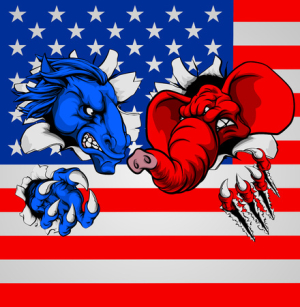By Dr. Ken Broda Bahm:

Written in the context of the civil rights and Vietnam war protests of the Sixties, there is an old Buffalo Springfield song with a line about the marchers, “Singing songs and carrying signs [that] mostly say, ‘hooray for our side.'” That ‘hooray’ is what the political psychologists call “partisan affect,” or the tendency to like and identify with those on your side of the political spectrum and to dislike and even demonize those on the other side. That is perhaps the reason that many of his supporters are sticking with embattled Alabama Senate candidate, Roy Moore, even in wake of inconsistent responses to the mounting allegations that he pursued and assaulted underage girls. Many are sticking with him because the alternative is that a Democrat might win. It is likely that a similar feeling motivated many Trump voters as well, and broadly, what many of his supporters seem to like the most about Trump is the degree to which he distresses liberals.
The phenomena of this partisan affect, is grounded in some research that might be pretty surprising. Santo Iyengar of Stanford and Sean Westwood of Princeton (Iyengar & Westwood, 2015) have noted that feelings of support and hostility based on political tribalism have increased dramatically in recent decades and are now greater than ever. In some ways, discrimination across the aisle might even be considered the new racism: “Hostile feelings for the opposing party are ingrained or automatic in voters’ minds, and that affective polarization based on party is just as strong as polarization based on race.” In this post, I’ll take a look at their research and discuss some of the implications.
The Research: Party Beats Race
Political party used to be seen as a relatively weak identifier in American life. Not any more. It is now one of the strongest identifiers researchers are able to measure. And it isn’t just self-reports that drive that importance. Iyengar and Westwood used implicit association measures in order to look at biases that lie below the levels of conscious awareness. The result is that party identification predicted both attitudes and behaviors toward others. The authors argue that we tend to classify members of the other party as an out-group, less deserving of respect and moral concern. Those partisan cues also influence decisions outside of politics, such as whether we would help someone or not.
The bias affects individuals in both parties, but among strong partisans, the effect is stronger for Republicans rather than Democrats. Iyengar and Westwood note that the divide is also reflected in other areas of life, as neighborhoods are becoming more politically homogenous, and parents are increasingly likely to say that they would disapprove if their child were to marry into a family with a different political belief.
Having increased dramatically since the 1980’s, partisan affect now tops race. “Compared with the most salient social divide in American society – race,” the authors write, “partisanship elicits more extreme evaluations and behavioral responses.” The fact that the divide exceeds race, they theorize, is due to an absence of norms governing negative expressions based on party. In other words, it is considered okay to disrespect political opponents, but not to disrespect members of another race.
The Implications: Be Aware and Adapt
Experienced litigators and consultants already focus on political leaning, but may not be aware that it is now more salient than even race. The implications of the research on increasing levels of partisan affect are to notice the cues and to adapt to them.
Notice the Cues (Theirs and Yours)
You can typically see gender and race just by looking. The same isn’t true of political identification, but the cues are still there to be read, even if the potential juror doesn’t walk in with a Greenpeace T-shirt or a ‘Make America Great Again’ red hat. Even if they’re nondescript in the courtroom, they probably aren’t in their social media. And make sure to apply the same analysis to yourselves that you apply to the members of your venire: What cues are you giving off that signal your tribe?
Factor It Into Your Strikes
One advantage to the prominence of political identity is that those who are the most extreme partisans are less likely to be shy about it. “While Americans are inclined to ‘hedge’ expressions of overt animosity toward racial minorities, immigrants, gays, and other marginalized groups,” the authors write, “they enthusiastically voice hostility for the opposing party and its supporters.” That means that you can often ask about it in voir dire, and add that to your assessment of who poses the greater potential risks to your case.
Transcend It In Your Message
Ultimately, if you need to persuade a partisan to support a party or a witness who is likely to see by your jury as representing a different political orientation, you need to be aware of the challenge. In that situation, anything you can do to ‘broaden the tribe’ by identifying shared circumstances and commitments, is a good thing.
______
Other Posts on Political Attitudes:
- Know the Limits of Political Empathy
- Think Beyond Just Red and Blue in Politics
- Adapt to Moral Division (Not Just PoliticalDivision)
______
Iyengar, S., & Westwood, S. J. (2015). Fear and loathing across party lines: New evidence on group polarization. American Journal of Political Science, 59(3), 690-707. URL: http://pcl.stanford.edu/research/2015/iyengar-ajps-group-polarization.pdf
Image credit: 123rf.com, used under license